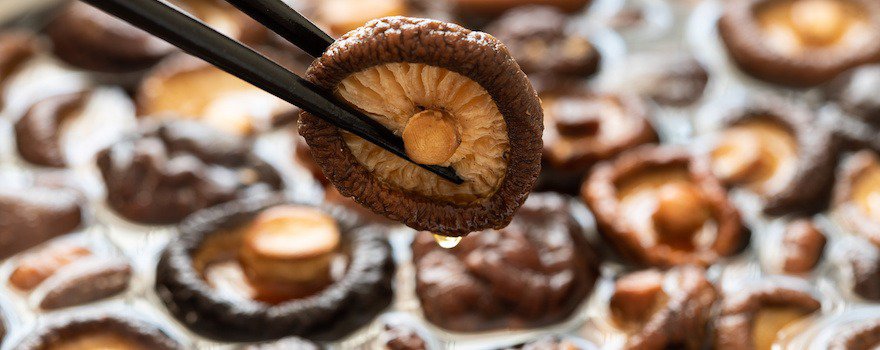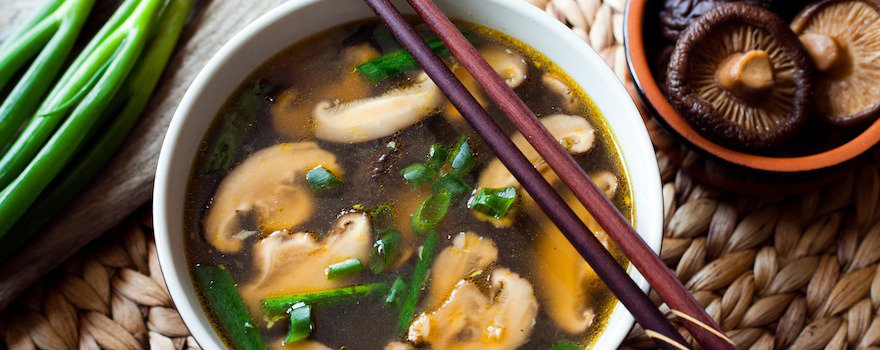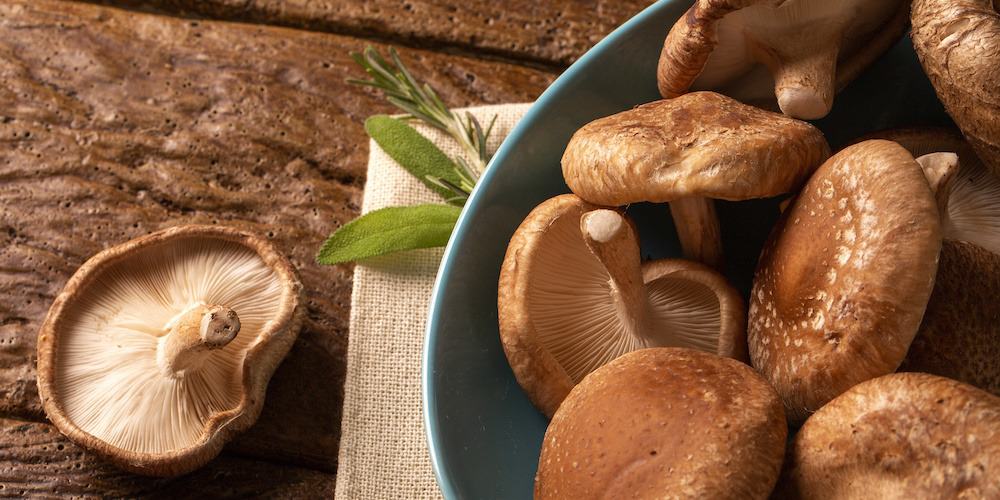BENEFITS OF SHIITAKE
✓ Potentially anti-cancer
✓ Stimulates the immune system
✓ Protects the heart
✓ Source of vitamin D
What is shiitake?
Shiitake is also called oak lentin or edible lentin – a literal translation of its Latin name (Lentinula Edodes). In gastronomy, it is known as the fragrant mushroom or the black mushroom.
It originates from the Far East. The oldest written record mentioning shiitake dates from the year 199, when it was presented to the Emperor of Japan by the Chinese. Today, this mushroom is the most cultivated species after the button mushroom! The Chinese have mastered its cultivation on logs since the 11th century and are currently the world’s largest producers.
Shiitake is used both in traditional medicine and gastronomy. It appears fresh or dried in many Chinese recipes, as well as Japanese or Korean dishes. Over the past twenty years, Europe and the United States have begun to take an interest in consuming this mushroom, riding the wave of interest in Eastern culture.
Westerners have been won over by the taste and therapeutic virtues of this super mushroom: an immune system booster, anti-inflammatory, good for the heart and vision.
As a natural remedy, it is consumed dried, in capsules, or as a liquid extract. Shiitake has an astonishing concentration of vitamins, and nutritional qualities rare for a single food.

Nutritional composition
- Proteins
- 18 amino acids (including 7 of the 8 essential ones)
- Fiber
- Vitamins : D, B2, B3, B5 and B6
- Minerals and trace elements : copper, selenium and zinc
- Polysaccharide : lentinan
The benefits of shiitake
🔬 Potentially anti-cancer
Shiitake contains lentinan, its main active compound, which is responsible for its anti-cancer properties. This polysaccharide (a sugar) has anti-tumor properties.
In China and Japan, lentinan is used to help treat stomach cancer. Furthermore, some claim that shiitake could destroy the human papillomavirus (HPV) and thereby protect against cervical cancer; however, scientific research is lacking to confirm this claim.
This study, conducted by Nanchang University in China, examined the role of polysaccharides, notably the lentinan, in the development of certain cancers. This other study, conducted by two Indian universities, shows the effectiveness of lentinan in reducing the spread of leukemia cells.
🛡 Stimulates the immune system
Lentinan also has properties that boost the immune system.
In Asia, it is used as an extract medicinally to help patients undergoing chemotherapy or people living with HIV, to boost their immune system.
However, European health authorities consider that the effectiveness of shiitake in strengthening immune defenses is not established.
This study conducted by various universities in Brazil and the United States with 52 people shows the effect of shiitake on immune system markers (inflammation levels…).
❤️ Protects the heart
There are several factors that make shiitake good for cardiovascular health.
Several of its chemical compounds — such as sterols or beta-glucans — have anti-cholesterol properties.
This study from the Korea Forest Research Institute in Seoul shows shiitake’s richness in beta-glucans and its effect against hypertension and high cholesterol. This other study conducted in Korea on rats shows that those who consumed shiitakes had healthier livers, less clogged arteries, and lower cholesterol levels than those who did not eat mushrooms.
🌞 Source of vitamin D
Shiitake is one of the few plant sources of vitamin D, providing 154 mg per 100 g.
vitamin D is essential for the proper functioning of the body through its role in bone mineralization.
It also plays a role in the prevention of fractures and cardiovascular events. A sufficient intake of vitamin D is essential for children — for growth, and for older adults — to prevent falls and osteoporosis.
Vitamin D is mainly found in fatty fish, organ meats and dairy products. Likewise, adequate sun exposure enables the body to properly synthesize vitamin D.
That is why shiitake is recommended for vegetarians, who need a source of plant-based vitamin D, and for people who have little sun exposure and are often deficient.
How to consume shiitake ?
Prefer organic shiitake
Mushrooms are among the organisms that absorb soil pollutants: in a highly polluted environment, it’s best not to consume specimens that grow there. That’s why it’s always best to know the origin of the mushrooms you eat.
Because shiitake is a cultivated mushroom, it can be bought organic. You can find organic shiitake, fresh or dried, in health food stores or online. You can even buy organic shiitake grown in France or grow them at home!
Fresh shiitake
Shiitake can be enjoyed as a standalone ingredient, cooked like a button mushroom. When fresh, it is eaten sautéed or grilled, served with meats or starchy foods, or in a wok with other vegetables.
Its aromatic fragrance stands up to long cooking: it can therefore also be stewed or braised. Although it can be eaten raw, it is nonetheless better to cook it due to possible inflammatory reactions.
As with all mushrooms, rinsing them before eating is not recommended because they can become waterlogged. You can quickly wash them with a vegetable brush to remove any possible residue.

Dried shiitake
You can often find dried shiitake on the shelves of Asian or health food stores. Dried shiitake has roughly the same nutritional values as fresh shiitake, so you can consume either to benefit from its therapeutic properties. Before consumption, dried shiitakes are rehydrated in water or broth for an hour.
Shiitake as a dietary supplement
Shiitake can be consumed as a dietary supplement. In this case, it is available as capsules (dried shiitake reduced to powder), as a liquid extract, in ampoules or bottles. In Asian countries, lentinan is also found as an isolated extract, used as a medicine.
However, it is considered preferable to consume the mushroom whole in order not to miss out on its richness in fiber, vitamins, and minerals.

Dosage
⚖️ Dried, it is recommended to eat 6 to 16 g per day to benefit from its therapeutic effects.
⏳ Shiitake can be eaten at any time, all the more so because there really isn’t a seasonality for this cultivated mushroom. Rich in vitamins, low in calories, and delicious: you can eat it regularly to stay healthy.
💊 As a dietary supplement, it may be prescribed in cases of a weakened immune system (a temporary or chronic illness, convalescence, change of season…). Sometimes in cases of mild hypercholesterolemia. In such cases, the dosage should be advised by a physician or a naturopath. It can also be taken as a course, not exceeding six to eight weeks to avoid dependence.
Contraindications and side effects
- It does not pose a danger if it is well cooked, but you should avoid eating raw shiitake, as it can cause a skin condition (a rash of small bumps called flagellate dermatitis).
- It is not recommended for people suffering from hypereosinophilia (an abnormal increase in white blood cells).
- Occasionally, shiitake can cause cases of hypereosinophilia or allergic reactions.
- Consumption of this mushroom can also lead to mild intestinal upset due to its high fiber content.

History and current cultivation
Shiitake is a mushroom that somewhat resembles the common button mushroom in shape, with a thinner stem and a light brown cap. Shiitake is now rarely found in the wild. So all the ones available commercially come from varieties cultivated in cellars or outdoors.
The most sought-after shiitakes are those with a thick cap, streaked with white and bearing a pattern that can sometimes resemble the shape of a flower, hence their nickname, the flower mushroom.
Although Asians remain the leaders in shiitake cultivation, some producers also grow it in France where it adapts well. It is better to favor the French shiitake to reduce your carbon footprint. Shiitake is cultivated in different ways: the traditional method, as practiced by the Japanese, is done on wood logs placed outdoors in a humid spot. The wood preferred by shiitake (oak lentin) is oak, the substrate on which it grows in the wild.
The Chinese tend to cultivate it rather on sawdust, a more economical and more ecological way to grow it. You can also find shiitakes cultivated on straw or on other organic residues: the shiitake is a saprophytic mushroom, meaning it feeds on decomposing plant material: in nature, its preferred substrate would be an old stump.
You can also grow shiitakes at home. Growing kits are available commercially to grow them on logs or on blocks of sawdust or straw. It is essential to be patient because incubation times are very slow, but their taste and freshness are priceless.
Finally, you can even find organic, Parisian shiitake, cultivated in an urban farm inside an abandoned parking garage in the north of the capital!
Also read the Under the cobblestones, the shiitakes! How La Caverne grows them in the heart of Paris
Detailed nutritional values
These data were compiled and verified for Darwin Nutrition by Laure Fourchaud, PhD in nutritional physiology.
| Shiitake (dried) | /100g | %RI* | /5g (1 tsp) | %RI |
| Energy (kcal) | 296 | 14,8 | 14,8 | 0,74 |
| Fiber (g) | 11,5 | 38,33 | 0,57 | 1,92 |
| Water (g) | 9,5 | — | 0,47 | — |
| Macronutrients | ||||
| Protein (g) | 9,58 | 19,16 | 0,48 | 0,96 |
| Carbohydrates (g) | 63,9 | 24,58 | 3,19 | 1,23 |
| Of which sugars (g) | 2,21 | 2,46 | 0,11 | 0,12 |
| Fat (g) | 0,99 | 1,41 | 0,049 | 0,07 |
| Minerals | ||||
| Calcium (mg) | 11 | 1,38 | 0,55 | 0,07 |
| Iron (mg) | 1,72 | 12,29 | 0,09 | 0,61 |
| Copper (mg) | 5,16 | 516,5 | 0,26 | 25,83 |
| Magnesium (mg) | 132 | 35,2 | 6,6 | 1,76 |
| Manganese (mg) | 1,18 | 58,8 | 0,06 | 2,94 |
| Phosphorus (mg) | 294 | 42 | 14,7 | 2,1 |
| Potassium (mg) | 1534 | 76,7 | 76,7 | 3,84 |
| Sodium (mg) | 13 | 0,52 | 0,65 | 0,03 |
| Salt (g) | 0,03 | 0,55 | 0,001 | 0,03 |
| Zinc (mg) | 7,66 | 76,6 | 0,38 | 3,83 |
| Vitamins | ||||
| Vitamin A (mg) | — | — | — | — |
| Vitamin C (mg) | 3,5 | 4,38 | 0,17 | 0,22 |
| Vitamin D (µg) | 3,9 | 78 | 0,19 | 3,9 |
| Vitamin E (mg) | — | — | — | — |
| Vitamin B1 (mg) | 0,3 | 27,27 | 0,01 | 1,36 |
| Vitamin B2 (mg) | 1,27 | 90,71 | 0,06 | 4,54 |
| Vitamin B3 (mg) | 14,1 | 88,13 | 0,705 | 4,41 |
| Vitamin B5 (mg) | 21,9 | 365 | 1,09 | 18,25 |
| Vitamin B6 (mg) | 0,97 | 69,29 | 0,05 | 3,46 |
| Vitamin B9 or folate (µg) | 163 | 81,5 | 8,15 | 4,08 |
| Vitamin B12 (µg) | — | — | — | — |
| Vitamin K (μg) | — | — | — | — |
*%AR : % Reference intake for an adult
Antioxidants: vitamins and minerals
Other compounds: polyols, lentinan
Report compiled by Pauline Petit and Charlotte Jean
Sources and scientific studies
U.S. Department of Agriculture, Agricultural Research Service (2014). USDA National Nutrient Database for Standard Reference, Release 27. Nutrient Data Laboratory Home Page, http://www.ars.usda.gov/ba/bhnrc/ndl
Extract from the 2009 Austrian polyols database via EuroFIR FoodEXplorer Food Production Daily.
German food agency warns about Shiitake mushroom. Foodproductiondaily.com



